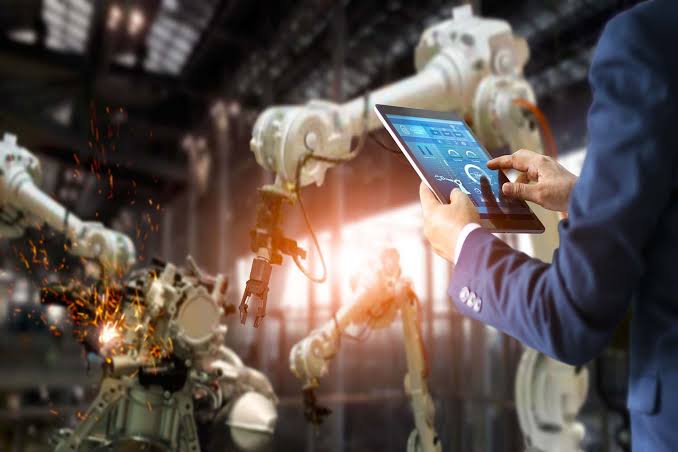
How Robotics Is Revolutionizing Manufacturing and Assembly Lines
Robots are bringing speed, precision, efficiency, and consistency that were once considered impossible in traditional factories. They can work tirelessly 24/7, reduce human error, and optimize every step of the production process. Today, smart robots are no longer a luxury for only large enterprises; they are becoming essential tools for manufacturers of all sizes.
✨ Raghav Jain

Introduction
Manufacturing has always been at the heart of industrial progress. From the first Industrial Revolution's steam engines to the advent of electricity and automation, each leap has significantly improved productivity and quality. Now, we stand at the edge of a new transformation—robotics. Intelligent machines are not just supporting but revolutionizing manufacturing and assembly lines.
Robots are bringing speed, precision, efficiency, and consistency that were once considered impossible in traditional factories. They can work tirelessly 24/7, reduce human error, and optimize every step of the production process. Today, smart robots are no longer a luxury for only large enterprises; they are becoming essential tools for manufacturers of all sizes.
In this article, we will explore how robotics is reshaping modern manufacturing, from the factory floor to the final product. We'll dive into the technologies behind robotic systems, their real-world applications, benefits, challenges, and what the future holds for this ever-evolving industry. The integration of robotics into manufacturing and assembly lines represents a paradigm shift, fundamentally altering the landscape of industrial production through enhanced efficiency, precision, flexibility, and safety; in contemporary manufacturing, robotic systems are no longer confined to simple, repetitive tasks but are increasingly sophisticated, intelligent, and adaptable, capable of performing complex operations such as intricate assembly, high-precision welding, delicate electronic component placement, and intricate painting with remarkable accuracy and consistency, far exceeding the capabilities of human workers in terms of speed and error reduction over sustained periods; this automation extends across diverse manufacturing sectors, from automotive production, where robots seamlessly execute body welding, painting, and component assembly on high-speed lines, to electronics manufacturing, where miniaturization and complexity demand the unwavering precision of robotic arms for circuit board assembly and quality control; the food and beverage industry benefits from robotic systems in packaging, palletizing, and even food processing, ensuring hygienic handling and consistent output, while the pharmaceutical industry leverages robots for sterile filling, labeling, and packaging of sensitive medications, adhering to stringent regulatory standards; a key driver of this revolution is the continuous advancement in robotic technologies, encompassing more dexterous and adaptable robotic arms with enhanced degrees of freedom and payload capacities, the development of sophisticated vision systems that enable robots to identify, inspect, and manipulate objects with human-like perception, and the integration of advanced sensors providing real-time feedback for process optimization and error correction; furthermore, the advent of collaborative robots, or cobots, marks a significant evolution, as these robots are designed to work safely alongside human workers without the need for physical barriers, enabling a synergistic human-robot interaction where humans contribute their cognitive abilities and problem-solving skills while robots handle physically demanding or repetitive tasks, leading to more flexible and efficient production workflows, particularly in scenarios involving high product variability or small batch sizes; the implementation of robotics also addresses critical challenges in modern manufacturing, such as labor shortages, the need for consistent product quality, and the demand for increased production output to meet global market demands; robots can operate continuously without fatigue, perform tasks in hazardous environments that would be unsafe for humans, and maintain a level of precision that reduces material waste and rework, contributing to significant cost savings and improved sustainability; the integration of robots is often coupled with other smart manufacturing technologies, such as the Industrial Internet of Things (IIoT), which connects robots and other equipment to a network, allowing for real-time data collection, analysis, and predictive maintenance, minimizing downtime and optimizing overall equipment effectiveness (OEE); artificial intelligence (AI) and machine learning (ML) are playing an increasingly vital role in enhancing the intelligence and autonomy of robots in manufacturing, enabling them to learn from data, adapt to changing conditions, optimize their movements and processes, and even perform self-diagnosis and predictive maintenance, further improving efficiency and reducing the need for constant human intervention; the future of robotics in manufacturing envisions even more sophisticated and integrated systems, where robots will possess greater levels of autonomy, dexterity, and cognitive abilities, seamlessly adapting to dynamic production environments, collaborating even more intuitively with human workers through advanced interfaces and communication methods, and playing a central role in fully automated or lights-out manufacturing facilities capable of operating with minimal human supervision; this evolution also includes the development of modular and reconfigurable robotic systems that can be easily adapted to different production tasks and product lines, providing manufacturers with greater flexibility and responsiveness to market changes; additive manufacturing, or 3D printing, is increasingly being integrated with robotic systems, allowing for on-demand production of customized parts and components, further blurring the lines between design, manufacturing, and assembly; however, the widespread adoption of robotics in manufacturing also presents challenges, including the initial investment costs, the need for a skilled workforce to program, maintain, and operate these advanced systems, and the potential impact on employment in certain sectors, necessitating proactive strategies for workforce retraining and the development of new skill sets to support this evolving industrial landscape; ultimately, the ongoing revolution of robotics in manufacturing and assembly lines is driving a transition towards more efficient, flexible, sustainable, and resilient production systems, paving the way for a future where intelligent machines and human ingenuity work in concert to create high-quality products with unprecedented speed and precision, transforming not only the way goods are made but also the nature of industrial work itself.
The Rise of Robotics in Manufacturing
The introduction of industrial robots began in the 1960s, primarily to perform repetitive tasks like welding and painting. Fast forward to today, and robotics has evolved into a highly intelligent, AI-integrated, sensor-driven field. Robots are now capable of:
- Autonomous decision-making
- Real-time quality inspection
- Collaborative interaction with human workers
The adoption of robotics is no longer limited to automobile plants or electronics giants. Sectors like textiles, food processing, pharmaceuticals, and even small-scale manufacturing units are embracing robotic solutions to stay competitive in a fast-paced global market.
Types of Robots Used in Manufacturing
Modern manufacturing benefits from a wide variety of robotic systems, each designed for specific tasks:
- Articulated Robots: These have rotary joints and are used in welding, material handling, and packaging.
- SCARA Robots (Selective Compliance Assembly Robot Arm): Ideal for high-speed pick-and-place or assembly operations.
- Cartesian Robots: Operate on three linear axes; commonly used in CNC machining and 3D printing.
- Collaborative Robots (Cobots): Designed to work safely alongside humans, cobots are transforming workspaces by combining the strengths of both human intelligence and robotic precision.
- Mobile Robots: Autonomous robots that navigate factory floors to transport materials, tools, or finished goods.
These robotic types are tailored to suit different production line needs and contribute to overall efficiency.
Key Benefits of Robotics in Manufacturing
Integrating robotics into manufacturing offers significant advantages, including:
1. Increased Productivity
Robots can operate 24/7 without fatigue, breaks, or human limitations. They significantly reduce cycle time, allowing manufacturers to produce more in less time.
2. Enhanced Precision and Quality
With precise programming and advanced sensors, robots can perform tasks like welding, cutting, or assembling with micrometer-level accuracy, reducing defects and improving product consistency.
3. Cost Efficiency in the Long Run
Though initial investment is high, robots reduce long-term costs by minimizing human error, decreasing material waste, and lowering labor expenses.
4. Improved Worker Safety
Robots take on hazardous tasks like heavy lifting, exposure to toxic substances, and working in extreme conditions, significantly reducing workplace injuries.
5. Customization and Flexibility
Modern robots can be reprogrammed and adapted for new products quickly, supporting flexible manufacturing and small-batch customization.
Smart Factories and Industry 4.0
The rise of robotics is central to Industry 4.0, a term used to describe the fourth industrial revolution where digital technologies drive production. Smart factories integrate:
- AI-powered robots
- Internet of Things (IoT) devices
- Cloud computing
- Big data analytics
In these environments, robots don’t just perform tasks—they communicate with machines, analyze data in real-time, and make autonomous decisions to optimize processes.
For instance, if a machine detects a misaligned component, it can alert other robots or stop the production line until the issue is resolved, preventing large-scale defects.
Real-World Applications in Assembly Lines
Across the globe, companies are using robotics to streamline their assembly processes:
- Automotive Industry: Robots handle everything from welding car frames to installing windshields. Tesla, for example, uses a highly automated production line with robotic arms, conveyors, and guided vehicles.
- Electronics Manufacturing: Companies like Foxconn use robots for assembling intricate components such as smartphones, tablets, and semiconductors with high accuracy.
- Food and Beverage Industry: Robots are used to sort, pack, label, and palletize products, ensuring hygiene and speed in operations.
- Pharmaceuticals: Robotic arms are used to fill, cap, and label medication bottles in sterile environments with minimal human contact.
- Consumer Goods: Robots handle repetitive packaging and labeling tasks for faster delivery to market.
Collaborative Robots (Cobots): A Game Changer
Unlike traditional robots, collaborative robots are designed to work with humans rather than replace them. Equipped with sensors and AI, they can:
- Respond to human touch and movement
- Stop when a person is nearby
- Be programmed easily with drag-and-drop interfaces
Cobots are ideal for small and medium-sized enterprises (SMEs) that can’t afford full automation but want to enhance productivity. They are used for:
- Light assembly
- Quality inspection
- Machine tending
- Packaging
This human-robot collaboration boosts output while maintaining human creativity and oversight.
Predictive Maintenance and Robotics
Robots are not just part of the production—they are also transforming equipment maintenance. Using IoT and AI, robots can monitor machine health, detect signs of wear and tear, and schedule maintenance before breakdowns happen.
This predictive maintenance approach minimizes downtime, extends the lifespan of machines, and ensures smoother production runs.
Challenges in Robotic Integration
Despite the advantages, there are still challenges in adopting robotics in manufacturing:
1. High Initial Investment
Robotic systems require significant upfront costs in hardware, software, and training.
2. Skill Gaps
Many workers need retraining to work with or program robots. There's a growing demand for technicians, engineers, and data analysts with robotics expertise.
3. Complex Implementation
Integrating robotics with legacy systems or existing infrastructure can be technically challenging and time-consuming.
4. Cybersecurity Risks
As robots become connected to networks, they become vulnerable to cyberattacks, requiring robust security protocols.
5. Ethical and Employment Concerns
Fears around job losses persist, especially in developing economies where manual labor is abundant. This highlights the need for thoughtful transition strategies and worker reskilling programs.
Case Studies: Robotics in Action
BMW Group
The car manufacturer uses over 3,000 robots in its factories worldwide. In their smart factories, robots handle everything from chassis welding to painting and even final inspection.
Adidas Speedfactory
Adidas launched a robot-powered factory to produce customized sneakers in record time. Though the factory closed due to high cost, it proved that fast, flexible production using robotics is possible.
Ocado Technology
This UK-based online grocer developed a robotic warehouse system where hundreds of robots sort groceries for delivery, optimizing speed and minimizing errors.
The Future of Robotics in Manufacturing
The robotics landscape continues to evolve rapidly. Here’s what we can expect in the near future:
- Greater Use of AI: Robots will become smarter, capable of handling more complex decisions and adapting to unpredictable environments.
- Robotics-as-a-Service (RaaS): Instead of buying, companies will rent robotic systems as needed, making automation accessible to smaller manufacturers.
- 5G Connectivity: With faster data transfer, robots will interact with cloud systems and each other in real-time, enhancing synchronization.
- Sustainable Manufacturing: Robots will be instrumental in reducing waste, optimizing energy use, and supporting eco-friendly production methods.
Ultimately, the manufacturing industry will become more responsive, resilient, and customizable, with robotics as a cornerstone of this transformation.
Conclusion
Robotics is no longer a futuristic concept—it’s a present-day reality that’s fundamentally transforming manufacturing and assembly lines. From automotive giants to small businesses, manufacturers are embracing intelligent machines to stay competitive, efficient, and innovative.
While challenges like high costs and workforce adaptation remain, the long-term benefits far outweigh the hurdles. Robotics offers unmatched advantages in precision, productivity, safety, and adaptability—making it a vital part of Industry 4.0 and the factories of tomorrow.
As technology continues to advance, the synergy between humans and robots will define the next era of manufacturing. Those who harness this collaboration wisely will not only survive but thrive in the ever-changing industrial landscape.
Q&A Section
Q1: What is robotics in the context of manufacturing?
Ans: Robotics in manufacturing refers to the use of automated machines, often programmable and equipped with sensors, to perform tasks like assembling, welding, painting, and packaging with precision and efficiency.
Q2: How has robotics improved efficiency on assembly lines?
Ans: Robotics has drastically improved efficiency by reducing production time, minimizing errors, enabling 24/7 operations, and increasing overall productivity without the need for constant human supervision.
Q3: What types of robots are commonly used in manufacturing?
Ans: Common types of robots include articulated robots, SCARA robots, delta robots, and collaborative robots (cobots), each designed for specific tasks like assembling, sorting, or transporting materials.
Q4: How do collaborative robots (cobots) enhance human-robot interaction?
Ans: Cobots are designed to work alongside humans safely, assisting in tasks that require flexibility and precision, thereby improving teamwork, reducing strain, and boosting efficiency.
Q5: In what ways do robots increase product quality?
Ans: Robots ensure consistent performance, precise measurements, and reduced human error, all of which contribute to uniform quality and fewer defective products in mass production.
Q6: How does robotics contribute to worker safety?
Ans: Robotics reduces the need for human workers to perform dangerous or repetitive tasks, thereby lowering the risk of workplace injuries and enhancing overall safety standards.
Q7: What is the role of AI in robotic manufacturing systems?
Ans: AI enables robots to learn, adapt, and optimize operations through data analysis, allowing smarter decision-making, predictive maintenance, and autonomous problem-solving.
Q8: How is robotics affecting employment in the manufacturing sector?
Ans: While robotics automates repetitive tasks, it also creates new job opportunities in robot maintenance, programming, and supervision, requiring workers to upskill and adapt.
Q9: What industries benefit the most from robotics in manufacturing?
Ans: Industries like automotive, electronics, aerospace, pharmaceuticals, and consumer goods benefit greatly from robotics due to their need for precision, speed, and large-scale production.
Q10: What are the future trends in robotics for manufacturing?
Ans: Future trends include smarter AI-driven robots, enhanced human-robot collaboration, real-time data integration, and increased customization in production through flexible robotic systems.
Summary (100 words):
Robotics is revolutionizing manufacturing and assembly lines by enhancing efficiency, safety, and precision. Automated machines now handle repetitive and complex tasks, enabling faster production and consistent product quality. From traditional industrial robots to collaborative robots (cobots), the integration of robotics minimizes human error and boosts productivity. With advancements in artificial intelligence, robots are becoming smarter and more adaptable. While this transformation requires the workforce to upskill, it also opens new opportunities in robotics management and tech-driven roles. As robotics continues to evolve, it is set to reshape global manufacturing with smarter, safer, and more cost-effective production processes.
Similar Articles
Find more relatable content in similar Articles

The Death of the Charging Port..
“As technology evolves, the tr.. Read More

The Dark Web Economy: What’s R..
Beneath the surface of the int.. Read More

Digital India: How Technology ..
Digital India leverages techn.. Read More

E-Waste Crisis: The Race to Bu..
The rapid growth of electronic.. Read More
Explore Other Categories
Explore many different categories of articles ranging from Gadgets to Security
Smart Devices, Gear & Innovations
Discover in-depth reviews, hands-on experiences, and expert insights on the newest gadgets—from smartphones to smartwatches, headphones, wearables, and everything in between. Stay ahead with the latest in tech gear
Apps That Power Your World
Explore essential mobile and desktop applications across all platforms. From productivity boosters to creative tools, we cover updates, recommendations, and how-tos to make your digital life easier and more efficient.
Tomorrow's Technology, Today's Insights
Dive into the world of emerging technologies, AI breakthroughs, space tech, robotics, and innovations shaping the future. Stay informed on what's next in the evolution of science and technology.
Protecting You in a Digital Age
Learn how to secure your data, protect your privacy, and understand the latest in online threats. We break down complex cybersecurity topics into practical advice for everyday users and professionals alike.
© 2025 Copyrights by rTechnology. All Rights Reserved.